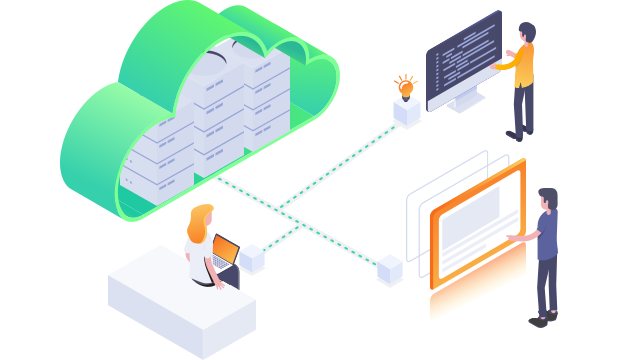Accelerate AI Innovation with Enterprise GPU Power and AI Studio
Bitdeer AI Cloud delivers secure, scalable GPU servers and an intuitive AI Studio platform to streamline AI and ML workflows. As an NVIDIA Preferred Partner, we provide top-tier compute power, real-time collaboration, scalable training, seamless model management, and secure storage—empowering faster, smarter innovation.

SEALMINER
Bitdeer's self-developed mining machine that harnesses the advanced SEAL series chip for exceptional efficiency, featuring a brand-new design architecture that maximizes chip potential, ensuring reliability, durability, and optimal performance even in harsh environments.
Resources
Navigate through our resource hub to find what you need. Subscribe to keep up-to-date with our latest news, announcements and blog posts.
Subscribe to our newsletter

Bitdeer’s Guide For Solo Mining In 2025
Jan 07 2025
Whether you are a curious novice or an experienced miner, this guide will assist you in deciding whether solo mining crypto is the appropriate road forward for you.
Some new miners driven by love for mining are entering solo mining as Bitcoin values exceed $100,000 and market excitement reaches fresh heights. Notwithstanding intense rivalry, hardware developments and creative ideas keep this method interesting. From its benefits and difficulties to advice for optimizing returns, this article explores all facets of solo mining in 2025. Whether you are a curious novice or an experienced miner, this guide will assist you in deciding whether solo mining crypto is the appropriate road forward for you.
What is solo mining?
solo cryptocurrency mining refers to the practice of individually mining digital currencies without setting your equipment in extensive mining farms. You mine alone in a private environment like your home or office. Using mining hardware, this autonomous approach solves cryptographic riddles, validates transactions, and adds blocks to the blockchain. Solo mining provides miners complete control and lets them retain all benefits, unlike pool mining when participants split processing power and rewards. Cointelegraph reports that a solitary Bitcoin miner successfully mined a block in 2021 earning 6.25 BTC. This emphasizes the few but significant benefits of solo mining.
Solo mining will still exist by 2025, although the success probability differs based on the cryptocurrency. Solo mining gives individual miners chances to optimize rewards in several highly profitable cryptocurrencies, given they can efficiently negotiate the obstacles.
Why consider solo mining in 2025?
For individuals looking for autonomy and control, solo mining remains appealing even if blockchain network difficulty and overall hashrate are continually rising. Reasons for choosing solo mining in 2025 could be a need for more profits. Once a block is effectively mined, the miner gets the whole solo mining rewards including transaction fees. Furthermore, the decentralized character of blockchain motivates miners to work on their own, hence lowering dependency on big mining pools. More importantly, solo mining gives more flexibility by letting miners choose cryptocurrencies that fit their tastes and approaches.
The facts as they stand reveal that single miners concentrating on niche coins can make large profits. For example, as highlighted by Crypto News Flash, on the Ethereum Classic(ETC) network because of reduced network rivalry, so solo mining rewards are appealing.
How to start solo mining?
Starting a solo mining business requires knowledge of basic procedures and cautious planning if you are new to cryptocurrencies. Selecting the best coins for solo miners is the most important thing. Seek coins with more profitability and return on investment; alternatively, investigate new cryptocurrencies. Although these coins can have little starting market worth, their future potential is great if their underlying technology or project value finds acceptance. Like Bitcoin in its first years, early-stage low-cost mining can yield significant rewards.
Next, you need to then arrange your mining hardware. To guarantee steady long-term operation, pay attention to energy efficiency and cooling capacity and invest in specialized mining rigs. Bitcoin uses ASIC miners, and GPUs are better suited for coins like Ethereum Classic. Connect your equipment to the blockchain network upon installation and set up a wallet to get your solo mining rewards.
Another absolutely important stage is the network configuration. Make sure your gadget is hooked to a reliable, low-latency network to prevent mining block rejection or interruptions. To stop overheating, routinely clean your gear; also, update your mining program to keep performance. Tracking indicators such hashrate, power usage, and temperature using performance monitoring tools will enable quick strategy modification.
How may you improve your mining strategy? Clearly state your objectives, including daily output or return rates, and evaluate your present profitability at regular intervals. Should the profitability of a particular currency drop, modify your mining strategy, just like by choosing a more profitable coin or mining pool to divide expenses.
Following this cryptocurrency mining guide, you can start a nice independent mining operation in 2025.
Is solo mining profitable?
Factors including hardware investment, electricity costs, and the mining difficulty of the selected coin mostly determine how profitable solo cryptocurrencies is. Since high-performance mining equipment sometimes requires a large upfront investment, it is imperative to assess the payback period and current market phase—that is, either a bull or bear market. Buying equipment during a bull market, for example, when prices are high could raise the financial risk should the market turn bearish before break-even. On the other hand, if your mining equipment is effective and the payback time is short, solo mining could make significant gains during a protracted bull market.
One of the main determinants of independent solo mining's profitability is power costs. Individual miners might have more energy costs than in big mining projects benefiting from lower electricity rates and economies of scale. This makes choosing hardware and designing operations heavily dependent on energy efficiency. Furthermore greatly affecting profitability is the network difficulty of the selected coin. Successful mining of a block decreases as mining difficulty rises. Should block rewards fall short of covering running expenses, solo mining may cause financial losses.
For miners aiming at niche or newly developed cryptocurrencies, solo mining can be rather profitable despite these hazards. Early-stage coins have special chances for more returns since they usually have less mining difficulty and less competition. Keeping an eye on solo mining trends and potential profitable coins for 2025 can help miners identify such opportunities.
Risks and challenges of solo mining
Solo mining is not without its challenges. Solo miners have more uncertainty in getting rewards without the combined computational capability of a mining pool. Success depends entirely on the miner's individual setup, which can result in long periods without any returns. Second, solitary miners have to pay for maintenance, electricity, and hardware whole-cost. These expenses can accrue quickly, especially with high-performance equipment, thereby lengthening the payback period.
Competition in the mining business continues to escalate, with large-scale mining operations employing improved technology and economies of scale. This puts individual crypto miners at a disadvantage, making it more tough to attain profitability.
Tips for successful solo mining
Increasing the profitability and efficiency of solo mining calls for both strategies. First, concentrate on choosing cryptocurrencies with either minimal network difficulties, steady rewards, or great development potential. Especially emerging cryptocurrencies could present less competition and more benefits in the early phases. Examine market developments and technical knowledge of project teams to find sustainable solutions.
Next, prioritize energy efficiency. To reduce electricity expenses, choose energy-saving technology including high-performance ASIC miners or GPUs, and look at renewable energy sources. This not only decreases running costs but also helps your mining to be more environmentally sustainable.
Moreover, staying updated and flexible is equally crucial. Keep a close eye on trends in the cryptocurrency industry, such as solo mining developments and technological advancements in 2025. Adjust your strategy promptly based on market conditions, whether by switching to more profitable coins or upgrading equipment, to maintain a competitive edge. Proper hardware maintenance and management are essential—update firmware regularly to ensure optimal performance, monitor hash rates, temperatures, and power consumption, and address any anomalies quickly. These steps can extend the lifespan of your equipment and improve overall efficiency.
Finally, diversifying risk is another key factor in achieving success with solo mining. Consider mining multiple cryptocurrencies simultaneously or allocating part of your hash power to coins with more stable returns. This approach not only enhances income stability but also increases your chances of capturing potential opportunities. By implementing these strategies comprehensively, solo miners can significantly improve their operational efficiency and profitability while being better prepared to navigate the challenges within the industry.
Learn more about cryptocurrency mining at Bitdeer
Bitdeer offers cutting-edge solutions for Bitcoin mining, including SEALMINER with top chips and one-click cloud mining services. Explore our platform for tools and resources to make solo mining simpler and more reliable. Visit Bitdeer to start your mining journey today.
*Information provided in this article is for general information and reference only and does not constitute nor is intended to be construed as any advertisement, professional advice, offer, solicitation, or recommendation to deal in any product. No guarantee, representation, warranty or undertaking, express or implied, is made as to the fairness, accuracy, timeliness, completeness or correctness of any information, or the future returns, performance or outcome of any product. Bitdeer expressly excludes any and all liability (to the extent permitted by applicable law) in respect of the information provided in this article, and in no event shall Bitdeer be liable to any person for any losses incurred or damages suffered as a result of any reliance on any information in this article.








